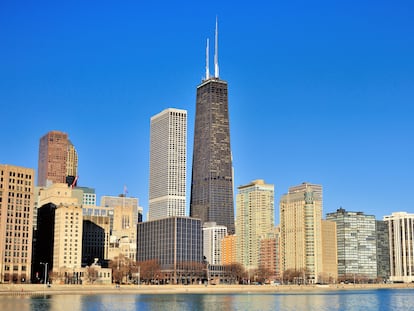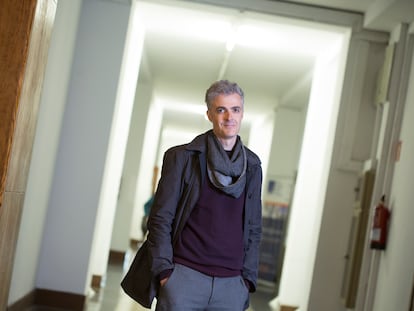David Rockwell, architect: ‘How do you protect the uniqueness of a store? Not everything can be Starbucks’
EL PAÍS visited the New York offices of the first architect to win a Tony Award and two Emmy Awards. The Rockwell Group — an architecture and design studio — will turn 40 in 2024. The firm is responsible for more than 30 Broadway sets and stages, including the 93rd edition of the Oscars

The Rockwell Group — David Rockwell’s architecture and design studio — is located in a Union Square building. The firm — which will turn 40 in 2024 — has a soundproof room with a Steinway piano and an old Eames lounge chair, made by Herman Miller. Whenever David, 67, isn’t in his office, it’s very likely that he’ll be in this room, rehearsing alone, or in the company of his private teacher.
The Chicago-born designer is a prolific space-maker. He is also the first architect to win a Tony Award and two Emmy Awards. He’s responsible for more than 30 sets for Broadway (the Tony Award was from a 2016 performance of She Loves Me) and various stages, such as the 93rd edition of the Oscars. Rockwell has also designed more than 500 restaurants, from Sushi Zen to New York classics, such as the Union Square Cafe or Carlotto. He also did the luminous Zaytinya — run by his friend the chef José Andrés, an impeccable tribute to the blues of Greece — or the impressive Sake No Hana, demonstrating pure Japanese refinement. On top of all this, Rockwell has designed 125 hotels (including New York EDITION and Rivera Maya EDITION), theaters such as the Hayes on Broadway or the Anthem in Washington, more than 40 boutiques, as well as major urban planning projects, from the JetBlue terminal at JFK Airport or Johns Hopkins University Bloomberg Center in Washington, DC.
The campus, which has a sophisticated interior, featuring murals by Ethiopian artist Elias Sime and Brazilian artist Sandra Cinto, was praised by the architecture critic for The New York Times, Michael Kimmelman: “David Rockwell and his Rockwell Group, the theater and hospitality specialists from New York, have converted the center’s atrium into a handsome, sunlit, wide-open complex of terraced classrooms and breakout spaces.” His projects always revolve around the same idea: people.
Today, the Rockwell Group has 330 employees, as well as offices in Madrid and Los Angeles. Over the past four decades, the team has worked with chefs and restaurateurs, including Robert De Niro (he’s a partner in Nobu), Alain Ducasse, Daniel Boulud, José Andrés, Jean-Georges Vongerichten, Danny Meyer, Gordon Ramsay, Marcus Samuelsson, Melba Wilson… the list goes on and on.
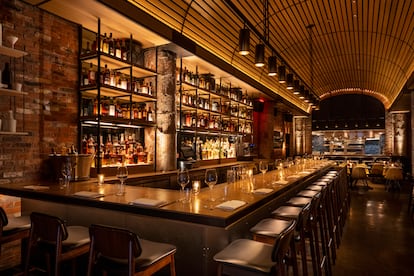
Among David Rockwell’s recent projects in New York is the public level of Perelman Performing Arts Center in the World Trade Center complex, including the arrival experience, lobby and restaurant. The Perelman was designed by REX in collaboration with executive architect Davis Brody Bond. The 138-foot-tall theater — home to emerging and established actors, musicians, filmmakers and opera singers — has an exterior lined with a mosaic of nearly 5,000 pieces of luminescent Portuguese marble, which is laminated on both sides with glass.
The Shed stands out as well. This cultural center — located in Hudson Yards, Manhattan — was designed by Diller Scofidio + Renfro (lead architect), with the Rockwell Group as collaborating architect. This innovative 200,000-square-foot structure is a flexible building: it can be moved, expanded and contracted, by rolling the telescopic cover on rails, just as the trains that once crossed over the same area once did. Next to it is 15 Hudson Yards, a residential skyscraper designed by Diller Scofidio + Renfro, with David Rockwell as chief interior architect. In the same area, Rockwell was in charge of the design of the Equinox Hotel, where the striking terrace — featuring sculptures by the Spanish artist Jaume Plensa — overlooks the Hudson River.
On a wall in David Rockwell’s office hangs a sketch of the set used in a production of Othello. Beneath it, there’s a quote from Shakespeare’s play: “We know what we are, but we don’t know what we can be.” It’s accompanied by a dedication: “To David, who not only has the vision to know what can be, but also the art to make it happen. We honor you for your inspired leadership and dedication to public theater.”
Whether they’re in schools, restaurants or theaters, Rockwell’s sets and interiors all have the feeling of a town square: they’re spaces for memory, which can be activated in different ways, with bright colors, or with walls filled with vegetation. They’re comforting structures — people can stop by and feel like they’ve been there all their lives.
David Rockwell opens the door and says hello. He’s holding lemon-and-mint juice (with lots of ice) in one hand. He wears black Levi’s and a sweater.
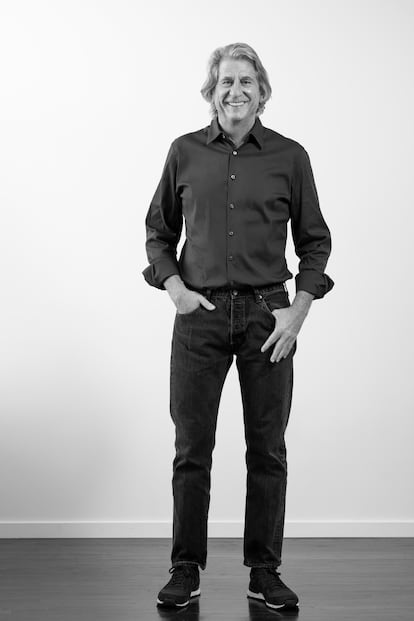
Question. When you were a child and they asked you what you wanted to be when you grew up, what did you answer?
Answer. I changed my answers very easily. At first, I wanted to be a pianist. My father played the piano — there was always one in my house but I never played [very] seriously. Luckily, six years ago, I started taking classes. I met a great pianist named Seymour Bernstein, who once played for Leonard Bernstein. He’s just turned 97 years old.
I was always building things. I was naturally interested in how to bring people together for moments of celebration. That’s something that comes, in part, because I had a lot of losses early on in my life and a lot of transitions. My father died when I was three and a half years old. My mother remarried and we moved to New Jersey. Among those transitions, I discovered theater.
Q. What do theaters and restaurants have in common?
A. Many things. They’re both places where communities meet. Connecting people is the most important part of my projects.
Q. When did you know that you were going to take the artistic path?
A. Maybe the year I went to architecture school, when I was 18. The fact [that I lived in] Guadalajara (Mexico) from the ages of 12 to 18 had a big influence on me, too. Back then, I spoke a lot of Spanish. Today, I don’t.
In Mexico, I became very interested in public architecture, thanks to the beautiful markets of Guadalajara, the plazas, the warm climate, the colors, the bullrings... so, I went to architecture school, with the idea that it would be interesting. But I wasn’t sure that architecture was for me until my second or third year, because the program was focused on the modern movement, with very rigid points of view that I didn’t share.
Q. The famous Mexican architect Luis Barragán made his first works in Guadalajara.
A. He’s one of my greatest influences.
Q. I was just about to ask you about who you’ve been most influenced by.
A. The most important influence [in my life] was my mother. She was a dancer. [I also admire] Boris Aronson, one of the greatest set designers of the 20th century. And Maxfield Parrish, the painter, because he was very interested in colors. And Luis Barragán, of course.
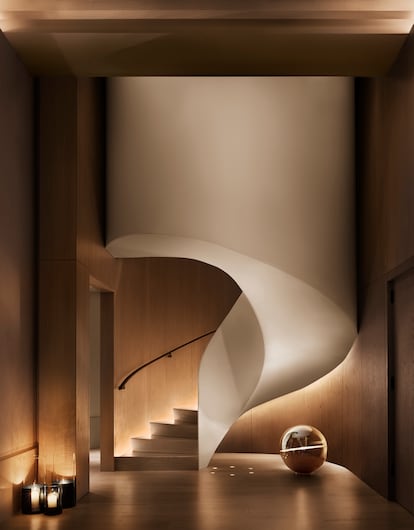
Q. You’re an architect by training and a designer by vocation. How did you go from one field to the other?
A. I think architecture is good training, because you learn to solve spatial problems and [work with others]. This is very important. When I created my own studio in 1984, the first thing they offered me was a restaurant. I didn’t know anything about restaurants. I knew more about theater. But the restaurant was a huge success and launched my career.
After that, I thought about the four things that interested me: hospitality, celebration, movement and telling stories. From there, I was able to tackle other types of projects.
Q. What does theater mean to you?
A. For me, it’s very interesting, because I have to see how to combine design, music, language and lighting to create a memory that lasts for a lifetime. Architects want to create permanent buildings. Theatrical designers create something that lasts for two hours. It’s totally different. Even if it’s the same production, it ends every night. Perhaps because I’ve always been aware that life doesn’t last forever, I understand how important it is to have moments of connection and celebration. Those are the two polarities: the creation of buildings that last forever… and the creation of moments that should last forever.
Q. What’s your favorite play?
A. I like Shakespeare... but I don’t have a favorite play. Right now, we’re doing [the set for] John Patrick Shanley’s Pulitzer Prize-winning Doubt. There’s a film version with Meryl Streep that I find fascinating… it’s about a Catholic priest and the woman who runs the convent. [It deals with] how to act when faced with doubt, when faced with the idea of uncertainty. It’s interesting right now, because we live in a very polarized present. Everyone is absolutely sure that they’re on the right or on the left: there’s [no room for self-doubt].
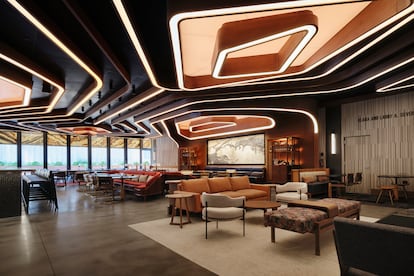
Q. When you started designing restaurants, they weren’t considered an opportunity for designers like they are now. The importance and visibility of chefs has changed. We also eat out more. How has the kitchen influenced design?
A. Well, the most important thing in a restaurant is the communion between the chef, the designer and the “producer.” We work together. There’s a saying in theater: it’s not good for the audience to come out whistling the set instead of whistling the music. The same thing goes for a restaurant. If you come out of one wondering why it was so pretty but the food wasn’t so great, I don’t think it will last long. But when you can find the combination, it’s formidable. I think that’s what happened with Nobu. Robert de Niro and I created a place that was unique and I think the service, food and design are so cohesive that it allowed [the establishment] to expand in a natural way.
Q. How important is lighting in your projects?
A. It’s number one. My interest in lighting took a turn when we moved to Mexico, because the quality of light in Guadalajara is incredible. Then, in architecture school, I took a semester off and worked on Broadway for a lighting designer. I understood how lighting sets the mood immediately. It’s multilayered: the light on the faces in the restaurant, the color of the food, different shots and scenes that make up a sequence… these aspects are often invisible to [the public, but they] affect everything.
Q. How does the design of a restaurant adapt to the history of a cuisine and, at the same time, to the history of a city and the traditions of its culture?
A. When designing a play, you start by reading the script and understanding the story scene by scene. With a restaurant, the script we [write] is a conversation with the chef, [so that we can] understand the place and its culture. A restaurant in New York isn’t the same as a restaurant in Mexico. In a restaurant, food is important… but also something as simple as a chair [is equally important]. Think about how personal the chair is and how long you’ll be sitting in it. Is it a chair meant for an hour and a half? Or is it a chair for two hours?
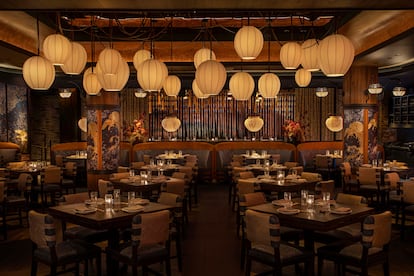
Q. I’m fascinated by the newly-opened space at the Perelman Performing Arts Center. What was the approach to this project?
A. I was very grateful to have been included in that project, because I worked on the redevelopment of downtown New York after 9/11 and have lived in Lower Manhattan for over 30 years. [At the Perelman, located in the new World Trade Center complex], we cannot forget that we’re in a theater, in a center of art. We wanted to create a space that was like a hug. If you go up the stairs, the first thing you see is the ceiling. You can’t see the ground. So, we said: “Let’s think of the roof as the welcome and let’s create a kind of flow that invites people to enter the building.” This has something to do with Barragán’s influence — contraction, decontraction, the surprises...
We wanted soft, textured and cozy surfaces, with felt walls, wooden lamps and lighting integrated into the profiles. There are many places to sit, but each one creates a small area. When you go to the theater in Europe, before and after, there’s space to have a drink. So, it was great to work on a project where a part of the lobby would have music and ample places to sit and chat and grab a bite to eat before and after the show. One of the things I consider most sacred in buildings is that the audience [members connect with each other].
Q. You’ve noted that vegetation is a kind of software for human life, compared to the hardware of buildings. To what extent is wildlife important in today’s cities?
A. I think it’s fundamental. When people ask me what my favorite building in New York is, I always say it’s Central Park. Green spaces are what make the city livable. One of the good things about New York is that it has 1,000 parks. We try to incorporate them into all our projects whenever we can.
Q. What has The Shed contributed to New York?
A. Well, [when I walked on the lot], it was just a railway line with overgrown weeds. I think The Shed has triggered the city’s imagination. It has allowed us to see New York from a different perspective. We used to observe it from below or from above — not from the center, as we do now — and [the project] also allows us to cross the city at a different speed. I think it’s been a success that has brought about an important transformation.
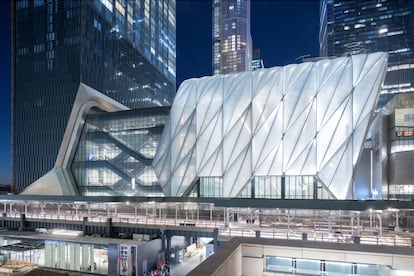
Q. How can New York City combat the constant invasion of ugly skyscrapers?
A. One [important thing] to understand is that the history of New York is a story of survivors.
Everyone looks at the sky, but you also have to look at the ground, at all the stores. How do you protect a unique and interesting store? Not everything can be Chipotle Mexican Grill or Starbucks. How can we avoid uniformity? I think we have to rethink how to use those spaces, the way in which we approach the ground floor and the skyscrapers.
I don’t know the answer… it’s a complicated question. After the destruction of Penn Station, landmark designations began in New York (to offer protection to certain historical buildings). There’s enough alarm among New Yorkers so that there’s now an evaluation process [regarding renovations, demolitions and new projects]. But then, you have to figure out who’s going to do the evaluation, who’s going to make the final decisions, what the criteria are… it’s an interesting subject, but I don’t have an answer for you.
Q. What has New York meant for your career?
A. I always knew that, sooner or later, I was going to settle in New York. I loved the friction of the city and its energy. It’s where my business is based, even though we have an office in Madrid and another in L.A. New York has many layers. I define myself as a New Yorker who loves the city and who has more or less spent my life studying it and trying to improve small parts of it.
Q. The result of your collaboration with Elizabeth Diller in The Shed is spectacular. What do you two have in common in terms of design?
A. We’re friends. There was a request for proposals — a bidding contest — by the city [government]. Twelve years before The Shed opened, Liz and I had worked together on a couple of smaller-scale things. I invited her to join a project we were doing in Hong Kong, then we did the [temporary viewing platform] around Ground Zero together in 2002. When we saw the repair proposal, we decided to join forces.
Q. What are the challenges for a New York-based architect — such as yourself — in terms of housing, materials and spatial performance in the face of climate change?
A. It’s an improbable, implausible city. It’s so compressed and so dense… I think it’s full of challenges. And every architect knows that climate change is a problem. The fact that politicians still aren’t convinced about this is mind-boggling. Still, I think there are everyday decisions we can make in terms of sustainability. Liz Diller and I agree that, as an architect, you don’t just respond to a client: you can also do things [for society]. I’m working on a project right now — which I can’t talk about too much — that has to do with [sustainable construction] for a non-profit organization.
Q. The other day, when we first met, you told me that you really like Barcelona. Can you elaborate?
A. I went several times when I was studying in London, because I was doing work at the Palau de la Música (a concert hall). I know that Gaudí gets all the press, but for me, Lluis Domènech i Montaner — and his building — are foundational. [His work] is so explosive and expressive. I also love Park Güell (an UNESCO World Heritage site). It’s probably one of the great parks in the world. I also love [Barcelona’s] street life.
Q. Speaking of parks, you’ve designed a few for kids. You’ve said that a design can emerge from a crisis. The Imagination Playground — made up of huge pieces of foam that kids can assemble as they please — was a response to 9/11. What do you prefer to work on: an airport, a restaurant, or a park?
A. For me, designing an airport or a playground is equally important. A playground is an opportunity to think about how design can improve our lives. There’s a long tradition of architects who have focused on playgrounds, such as Isamu Noguchi, Frank Gehry, or Richard Dattner.
Sign up for our weekly newsletter to get more English-language news coverage from EL PAÍS USA Edition
Tu suscripción se está usando en otro dispositivo
¿Quieres añadir otro usuario a tu suscripción?
Si continúas leyendo en este dispositivo, no se podrá leer en el otro.
FlechaTu suscripción se está usando en otro dispositivo y solo puedes acceder a EL PAÍS desde un dispositivo a la vez.
Si quieres compartir tu cuenta, cambia tu suscripción a la modalidad Premium, así podrás añadir otro usuario. Cada uno accederá con su propia cuenta de email, lo que os permitirá personalizar vuestra experiencia en EL PAÍS.
¿Tienes una suscripción de empresa? Accede aquí para contratar más cuentas.
En el caso de no saber quién está usando tu cuenta, te recomendamos cambiar tu contraseña aquí.
Si decides continuar compartiendo tu cuenta, este mensaje se mostrará en tu dispositivo y en el de la otra persona que está usando tu cuenta de forma indefinida, afectando a tu experiencia de lectura. Puedes consultar aquí los términos y condiciones de la suscripción digital.
More information
Archived In
Últimas noticias
Most viewed
- Reinhard Genzel, Nobel laureate in physics: ‘One-minute videos will never give you the truth’
- Oona Chaplin: ‘I told James Cameron that I was living in a treehouse and starting a permaculture project with a friend’
- Pablo Escobar’s hippos: A serious environmental problem, 40 years on
- Chevy Chase, the beloved comedian who was a monster off camera: ‘Not everyone hated him, just the people who’ve worked with him’
- Why we lost the habit of sleeping in two segments and how that changed our sense of time

